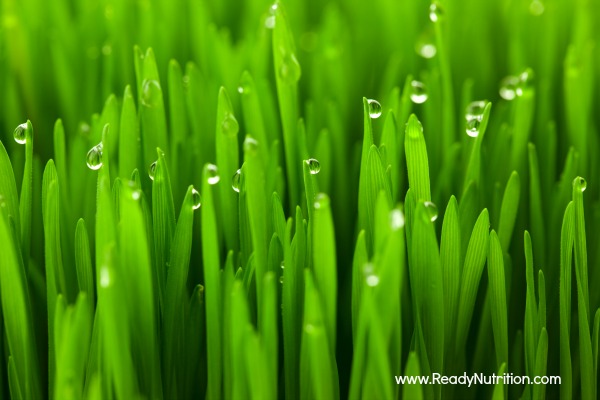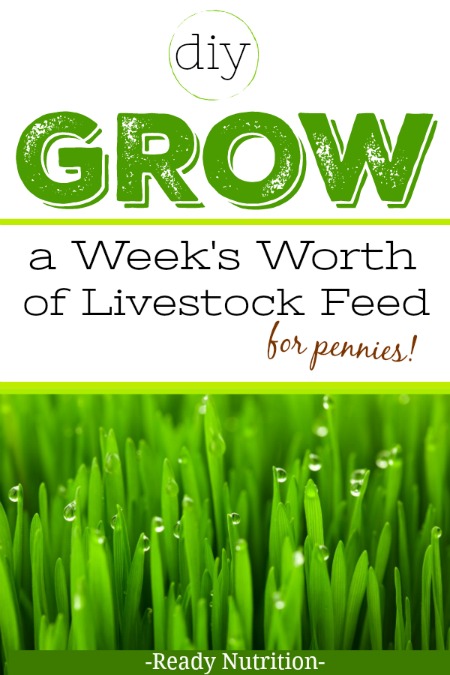
Similar to sprouting seeds for our own nutritional benefit, we wanted to do the same for our livestock. 1 pound of seed can grow up to six or 7 pounds of fodder thus providing you with more nutrient dense food for your livestock. Sprouts provide the highest amount of vitamins, minerals, proteins, and enzymes of any of food per unit of calorie. Enzymes are essential because they heal the body, cleanse the body, prevent diseases, enhance the general functioning of bodily organs, aid in digestion, and remove gas from the stomach. This will help your livestock stay healthier in the long run and give them a natural diet in the process. Of course, the increase in these wonderful benefits varies grain to grain.
Fodder Cuts Your Livestock Feed Prices in Half
All livestock animals can benefit from a fodder-rich diet. Creating a fodder system for small livestock such as goats, rabbits and chickens can be maintained on a small scale. They will love this green treat and you will love how economic it is compared to buying large bags of livestock feed on a monthly basis. You can literally cut your feed bill in half by growing fodder!
Before you begin growing fodder, make sure you know how much seed to start in order to properly feed your livestock. Further, transitioning your livestock off its current diet will ensure their stomachs get used to the new diet. According to an article at Mother Earth News, “As any responsible animal or livestock caretaker, you will not only need to transition your animals onto fresh fodder, you will need to monitor their growth and maintenance rates to keep them in a healthy condition while you get used to feeding fodder. Some animals will also require roughage or mineral supplements.” Please only use these amounts as a guide:
- Horse: 2-3 percent of their body weight in fodder; 1.5% body weight in dry hay
- Beef Cow: 2-3 percent of their body weight in fodder; barley straw ration
- Dairy Cow: 3-5 percent of their body weight in fodder; barley straw ration
- Sheep: 2-3 percent of their body weight in fodder; hay ration
- Goat: 2-3 percent of their body weight in fodder; mineral and hay rations
- Dairy Goat: 3-5 percent of their body weight in fodder; mineral and hay rations
- Alpaca: 2-3 percent of their body weight in fodder; hay ration
- Pig: 2-3 percent of their body weight in fodder
- Rabbit: 3-5 percent of their body weight in fodder; hay ration for roughage
- Chicken: 2-3 percent of their body weight in fodder; grit and calcium supplements
5 Easy Steps to Growing Fodder
Here’s what you need to make a simple fodder system for a small farm:
- 20 Black seedling trays with plastic domes, plastic containers or disposable aluminum pans
- The bulk amount of seeds you plan to sprout. Ensure these are untreated, feed grade seeds that are whole grain
- Water
- Sunny window
- Spray bottle or watering can
- PVC pipe for titling trays
Instructions:
- Gather the seeds you want to sprout and soak them in water overnight.
- In the morning, drain the seeds and cover with a plastic cover. Place them in the sprouting trays in a sunny location.
- Water up to 3 times a day – never allowing the seeds to dry out.
- By day 7, the roots of the seeds will have intertwined and you will be able to peel the fodder out of the pan.
- Repeat as often as needed.
This video shows a great way of creating a weeks worth of feed for livestock using a shelving unit, plastic bins and cut PVC pipe.
Additional Notes on Growing Fodder:
- Growing fodder requires certain temperatures in order to grow properly. Plan on fodder growing between 65-75 degrees F.
- Water up to three times a day.
- Do not reuse your water as this can pass food-borne illnesses to trays.
- You want to avoid feeding your chickens dry beans as they contain toxins. Here are some other foods to avoid feeding your chickens.
- Fodder is usually finished growing in 7-8 days.
- Get seed from a local feed store or grain mill or a local co-op
- When sprouted grains are 6-7 inches high, they are ready to be harvested and fed to livestock.
- Mold and fungus growth can be a problem. Sterile equipment, a low humidity environment, good temperature regulation, clean water, and good air circulation can all help avoid mold and fungus problems. A one percent bleach solution can be used to wash the grains prior to the initial soaking. This will pre-sterilize the seed.
Creating your own fodder system is an economic solution to ensuring your livestock receives a well-rounded diet. Best of all, the upkeep is minimal at best and you don’t use as much feed using this feeding process. This nutrient-dense diet will keep your animals healthier and happier in the process, thus reducing vet bills. Keep these tips in mind and create an ever-growing fodder system for your livestock.
Additional Resources:
DIY Sprouted Fodder For Livestock

This article was originally published at Ready Nutrition™ on January 24th, 2015






